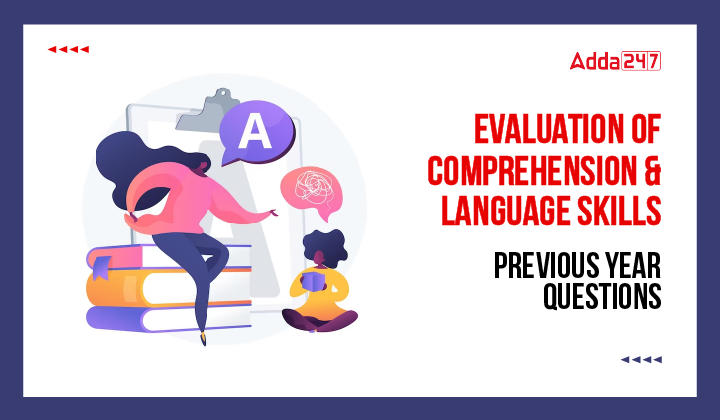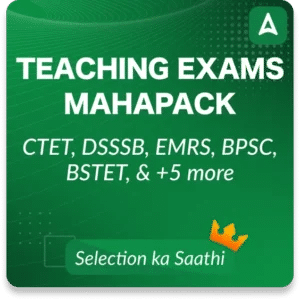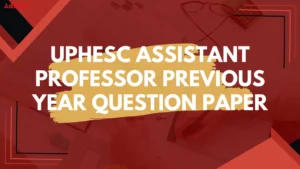In teaching exams like CTET and other State TETs, English is a mandatory component, including 15 questions on English content and 15 questions on English Pedagogy. English Pedagogy is a noteworthy and captivating topic within the English Language sections of exams such as CTET and other TET Exams. To aid your preparation, this article provides a compilation of previous year questions organized by topic.
Evaluation of Comprehension & Language Skills (Previous Year Questions)
Q1. Criteria of assessment is a / are
(a) guidelines with marking scheme
(b) questions – wise distribution of marks
(c) general impression of a student’s ability
(d) scoring key
Q2. Which of the following statements is true?
(a) All formative tasks are meant for assessment
(b) Formative assessment, to be effective, must be conducted only after teaching a lesson
(c) While all formative tasks are meant for improving
(d) Formative assessment helps us to grade students into good, average and poor
Q3. A rhetorical question is asked
(a) to gather personal information
(b) to clarify a concept
(c) for the sake of effect with no answer needed
(d) to get a feedback about what others think about you speech / writing
Q4. What type of questions promote thinking skills in children?
(a) Factual question
(b) Questions based on purely on the reading text
(c) Personal response question
(d) Closed – ended questions
Q5. Which of the following will help learners take greater responsibility for their own learning?
(a) Supervised reading sessions
(b) Controlled writing tasks
(c) Peer Assessment
(d) Summative Assessment
Q6. The main purpose of assessment is
(a) to measure achievement of learners
(b) to give practice in writing
(c) to improve the teaching learning process
(d) to decide pass and fail
Q7. When young learners are taught to improve their spelling and punctuation, they will
(a) enhance their fluency
(b) nurture their creativity
(c) Sharpen their listing skills
(d) improve their accuracy
Q8. Instead of asking questions and getting answer from her learners, a teacher gives some short texts and asks her learners to frame questions. Her primary objective is to
(a) Take their help during examination
(b) Make the learners realize the difficulties faced by teacher in preparing question papers
(c) Enhance the learner’s analytical and critical thinking
(d) Train the learners as good question paper setters
Q9. Reading between the lines as a sub – skill reading mainly involves
(a) understanding the states facts
(b) giving sufficient space between lines
(c) inferring the unstated using the contextual and verbal clues
(d) identifying the grammatical item
Q10. To inculcate a ‘Never Give Up Attitude’, a suitable activity is one when students
(a) Managed to get the principal’s permission to go out and play during the English period
(b) Song two popular songs and exhibited some of their art and craft works during the parent-teacher meet
(c) Made modifications to their paper planes and tested them again, experimented with the best way to get them to go the distance and shared their finding
(d) In groups created graphs about the difficult situations that students have had to face in life
Q11. While ‘evaluating students’ responses for reading comprehension, marks may be deducted for __________ errors.
(a) grammatical
(b) syntactical
(c) content
(d) Spelling
Q12. A text that requires students to scan in order to understand and analyze the writer’s message and purpose could be
(a) an encyclopedic extract
(b) a newspaper headline
(c) a set of instructions to assemble a device
(d) a poem
Q13. While drafting a notice, students may be instructed to use language
(a) direct
(b) intrigue
(c) descriptive
(d) elaborated
Q14. For evaluating a poster designed as a part of a competition, which of the following criteria would be the most appropriate for the judges?
(a) Relevant content, style and word limit
(b) Use of quotation, style and visual appeal
(c) Creativity, relevant content and visual appeal
(d) Creativity, fonts and visual appeal
Q15. While teaching children to read, at which point should the teacher focus on comprehension?
(a) When children reach class II
(b) After children have learned how to decode
(c) Right from the beginning
(d) Once children have mastered phonics
SOLUTIONS
S1. Ans.(c)
Sol. Assessment criteria are statements specifying the standards that must be met and the evidence that will be gathered to demonstrate the achievement of learning outcomes. The purpose of assessment criteria is to establish clear and unambiguous standards of achievement for each learning outcome. Hence, the Criteria of assessment are a general impression of student’s ability.
S2. Ans.(c)
Sol. While all formative tasks are meant for improving.
S3. Ans.(c)
Sol. A rhetorical question is asked, “for the sake of effect with no answer needed”. A rhetorical question is a figure of speech in the form of a question that is asked in order to make a point rather than to elicit an answer.
S4. Ans.(c)
Sol. When students answer personal response questions, it enlightens their thought process and makes them think harder about a problem.
S5. Ans.(c)
Sol. Peer assessment or peer review provides a structured learning process for students to critique and provide feedback to each other on their work. It helps students develop lifelong skills in assessing and providing feedback to others, and also equips them with skills to self-assess and improve their own work.
S6. Ans.(a)
Sol. The purpose of assessment is to gather relevant information about student performance or progress, or to determine student interests to make judgments about their learning process.
S7. Ans.(d)
Sol. When young learners are taught to improve their spelling and punctuation, they will improve their accuracy.
S8. Ans.(c)
Sol. Instead of asking questions and getting answer from her learners, a teacher gives some short texts and asks her learners to frame questions. Her primary objective is to enhance the learner’s analytical and critical thinking.
S9. Ans.(c)
Sol. Reading between the lines as a sub–skill reading mainly involves inferring the unstated using contextual and verbal clues.
S10. Ans.(c)
Sol. To inculcate a ‘Never Give Up Attitude’, a suitable activity is the one when students made modifications to their paper planes and tested them again, experimented with the best way to get them to go the distance and shared their finding.
S11. Ans.(c)
Sol. The marks of students may be deducted for their content errors.
S12. Ans.(d)
Sol. A text that requires students to scan in order to understand and analyze the writer’s message and purpose could be a poem.
S13. Ans.(a)
Sol. In drafting a notice the students are instructed to use direct language.
S14. Ans.(c)
Sol. Creativity, relevant content and visual appeal.
S15. Ans.(c)
Sol. While teaching children to read, the teacher should focus right from the beginning of comprehension.




 UGC NET Previous Year Question Paper, Do...
UGC NET Previous Year Question Paper, Do...
 UP GIC Lecturer Previous Year Question P...
UP GIC Lecturer Previous Year Question P...
 UPHESC Assistant Professor Previous Year...
UPHESC Assistant Professor Previous Year...














